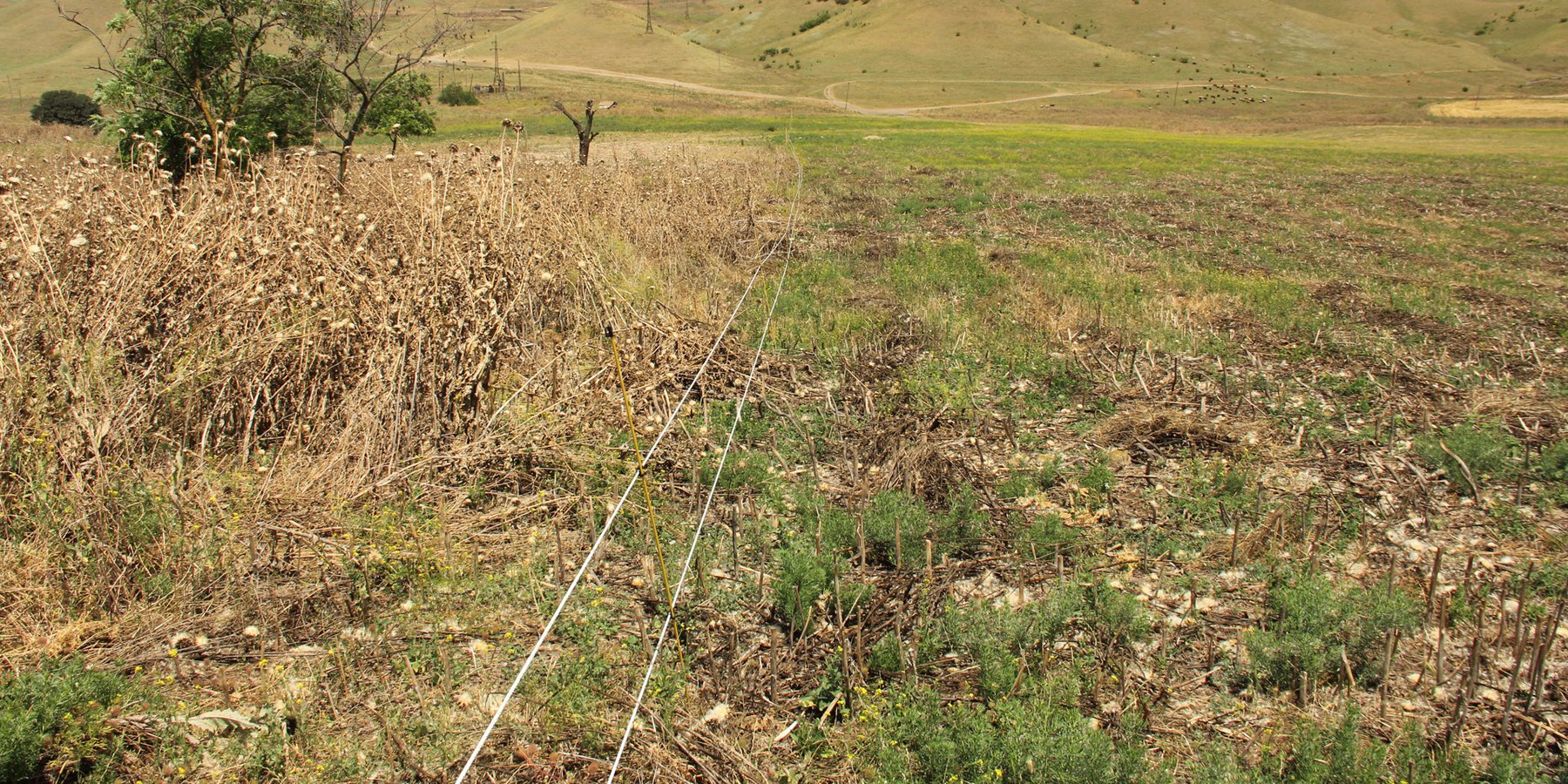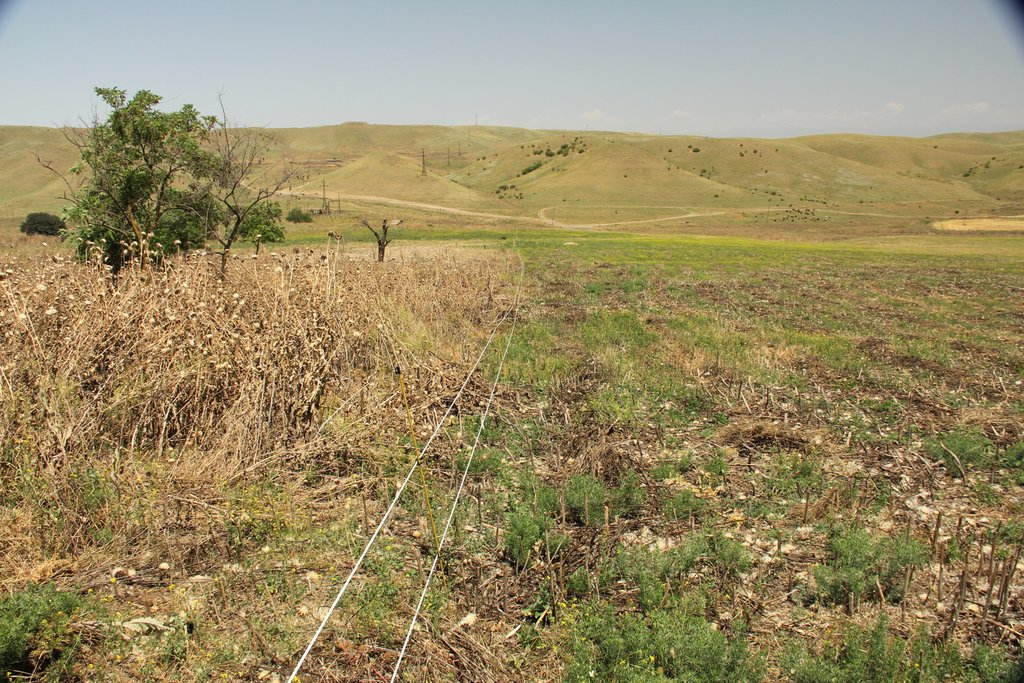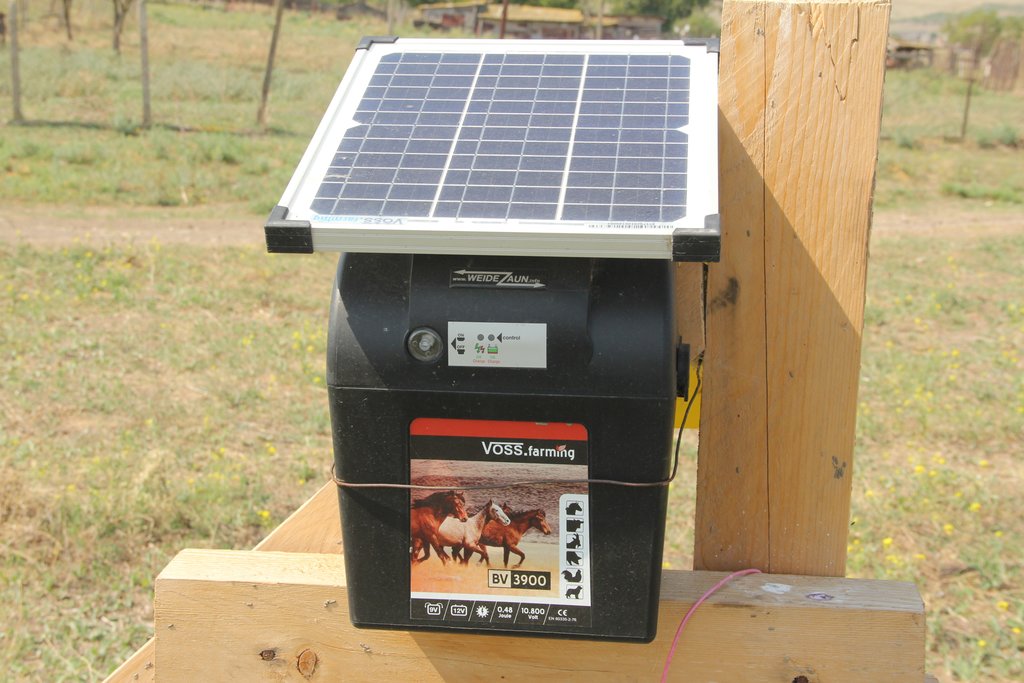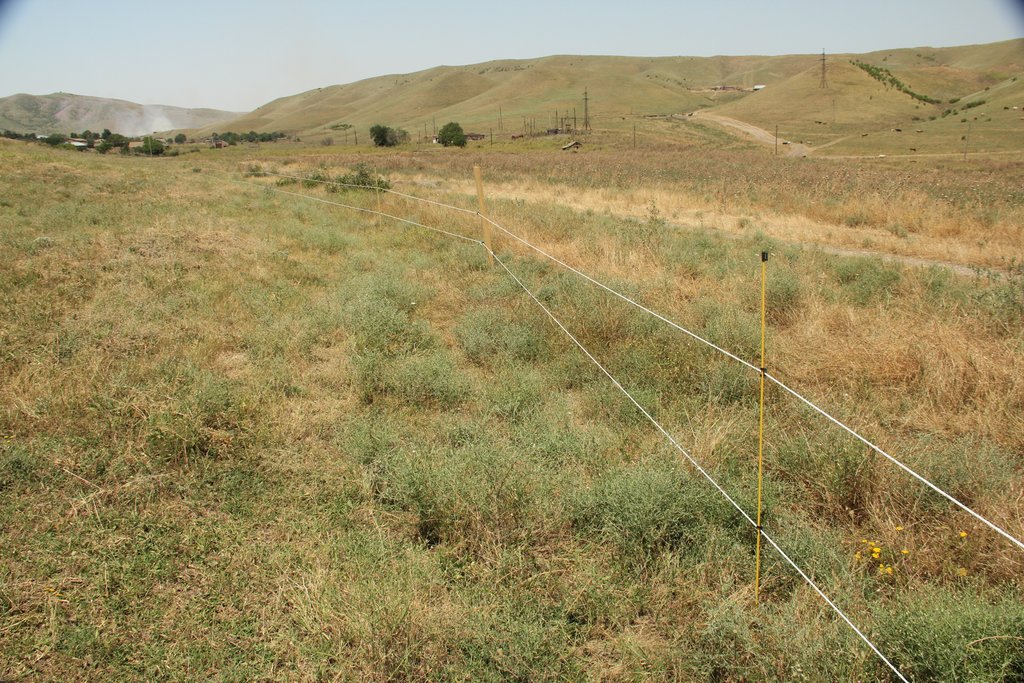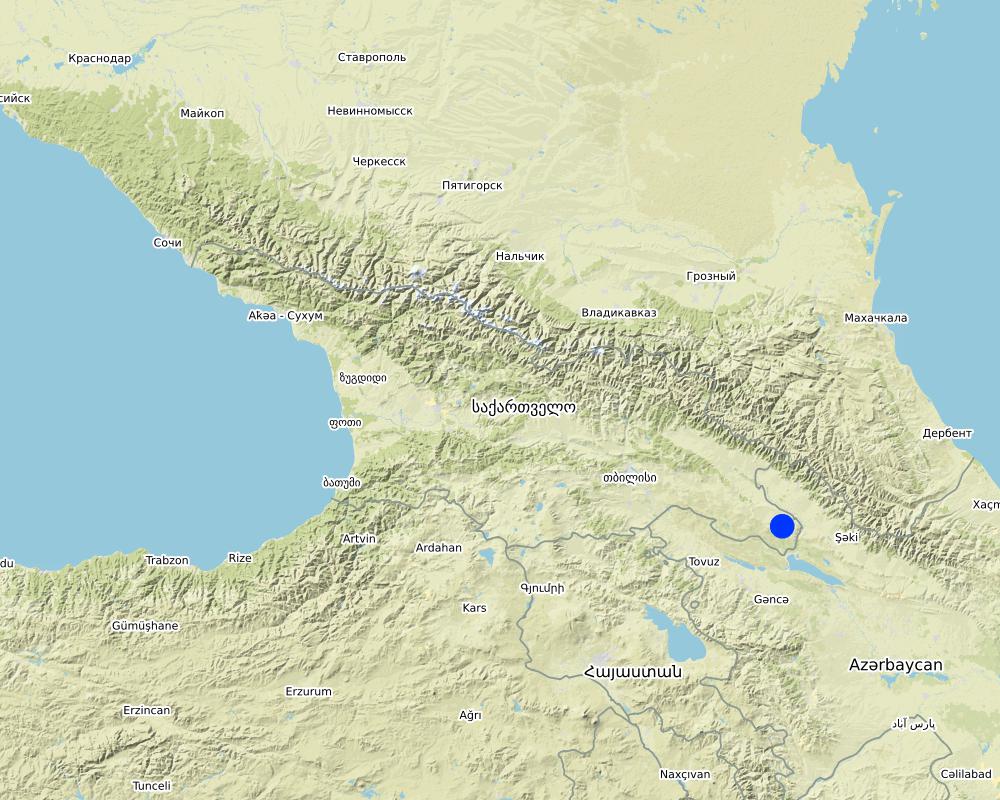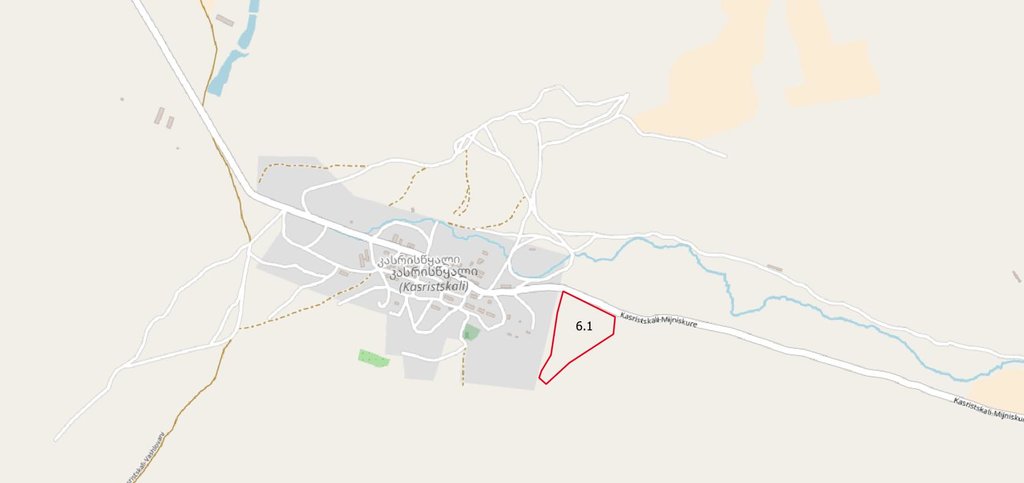Establishment of a paddock system and improvement of degraded pastureland. [乔治亚]
- 创建:
- 更新:
- 编制者: Hanns Kirchmeir
- 编辑者: Kety Tsereteli
- 审查者: Rima Mekdaschi Studer
technologies_4276 - 乔治亚
查看章节
全部展开 全部收起1. 一般信息
1.2 参与该技术评估和文件编制的资源人员和机构的联系方式
co-compiler:
有助于对技术进行记录/评估的项目名称(如相关)
Applying Landscape and Sustainable Land Management (L-SLM) for mitigating land degradation and contributing to poverty reduction in rural area (L-SLM Project)有助于对技术进行记录/评估的机构名称(如相关)
Regional Environmental Centre for the Caucasus (REC Caucasus) - 乔治亚1.3 关于使用通过WOCAT记录的数据的条件
编制者和关键资源人员接受有关使用通过WOCAT记录数据的条件。:
是
1.4 所述技术的可持续性声明
这里所描述的技术在土地退化方面是否存在问题,导致无法被认为是一种可持续的土地管理技术?:
否
1.5 参考关于SLM方法(使用WOCAT记录的SLM方法)的调查问卷
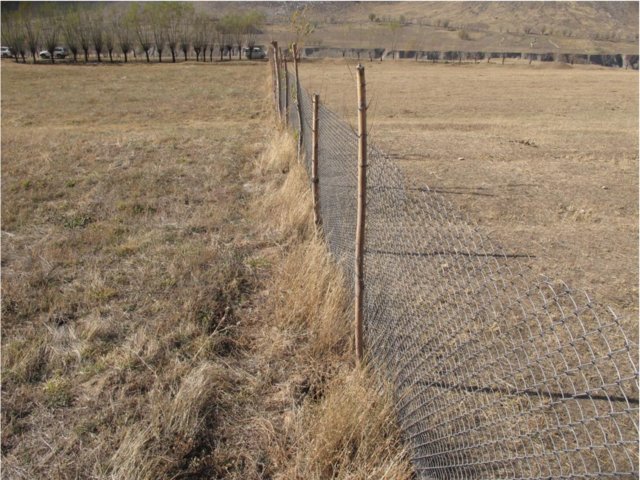
Rehabilitation of Pasture Land through fencing [塔吉克斯坦]
The approach demonstrates the effect and importance of rotational grazing by fencing certain areas of land in pasture areas as well as it demonstrates the rehabilitation process in comparison to the open space which is overgrazed. The approach involves mobilizing communities to observe the rehabilitation process by not grasing in …
- 编制者: Askarsho Zevarshoev
2. SLM技术的说明
2.1 技术简介
技术定义:
In a pilot project, degraded pastureland near the settlement of Kasristskali was regenerated by introducing a fencing, mowing and grazing regime that favours the growth of forage plants instead of weeds and, where necessary, reseeding forage plants.
2.2 技术的详细说明
说明:
This showcase is part of the project "Applying Landscape and Sustainable Land Management (L-SLM) for mitigating land degradation and contributing to poverty reduction in rural areas", implemented by the Regional Environmental Center for the Caucasus (REC C).
The implementation site was selected by national experts together with stakeholders from the village. This site is located close to the settlement Kasristskali. It is community pastureland, which was abandoned and not maintained for many years. The site had been dominated by thistles and weeds before the intervention took place and was not suitable for grazing. 30% of the area was previously used to store manure and is rich in nutrients. To reclaim the pastureland for cattle, an area of 6.1 ha was mowed twice and equipped with an electric fence (two lines of electric wire and a solar-powered energizer brand Voss). This was done to regenerate the area so that a grazing regime could be introduced later. An electric fence was chosen because wood is not available in the area and a wire mesh fence would be more expensive. Furthermore, an electric fence is flexibly adjustable, which is essential for a rotational grazing system. It is important to remove the residues after the mowing to reduce the amount of weed seed. The time of mowing should be before the flowering of the most common weed species. An ongoing mowing and grazing regime was set up to favour fodder plants instead of weeds: Since the cows only eat the fodder plants and leave the weeds standing, the weeds have a clear advantage. To counteract this, the weeds are mowed, and fodder plants are sown. Mowing is needed for the first 2 years and after that, it is enough to control the quality of pastureland by a grazing system. For maintenance purposes, the area was cut once in early spring and a second time in summer. The evaluation in September, after the pastureland was recultivated, showed that the northern and eastern parts now have a grass and herb cover suitable for grazing, while the central, western and southern parts are still overgrown by weeds. This is due to the fact that these parts were very rich in nutrients from the very beginning and consisted exclusively of thistles. In order to improve the productivity of the site, it is recommended to cut the vegetation again in autumn, remove the residues, open the soil with a harrow and sow a pasture seed mixture adapted to the climatic conditions in February.
The local community farmers were involved in all activities. They were participated in development of local pasture management plan. The plan was approved by the community members and they are ready to follow the applied methodology and maintain the pastureland after the project completion. The farmers acknowledged the benefit from the proposed methodology and they invested to rehabilitate the additional area (6 ha) of pastureland with their own financial sources.
The 6.1 ha plot which was restored as pastureland with this technology is planned to be used as a paddock for alternating grazing between free-range and the paddock.
2.3 技术照片
2.5 已应用该技术的、本评估所涵盖的国家/地区/地点
国家:
乔治亚
区域/州/省:
Kakheti
有关地点的进一步说明:
Municpalty of Akhmeta, Kasristskali village
具体说明该技术的分布:
- 适用于特定场所/集中在较小区域
技术现场是否位于永久保护区?:
否
注释:
The national park Vashlovani is nearby.
Map
×2.6 实施日期
注明实施年份:
2018
2.7 技术介绍
详细说明该技术是如何引入的:
- 通过项目/外部干预
注释(项目类型等):
Applying Landscape and Sustainable Land Management (L-SLM) for mitigating land degradation and contributing to poverty reduction in rural areas; GEF funded, implementation by the Regional Environmental Center for the Caucasus (REC).
3. SLM技术的分类
3.1 该技术的主要目的
- 改良生产
- 减少、预防、恢复土地退化
3.2 应用该技术的当前土地利用类型
同一土地单元内混合使用的土地::
否

不毛之地
具体说明:
The area east of the village is rich in nutrients but was not maintained. A dense weed layer of milk thistle (Silybum marianum) was established.
注释:
The main income of the village comes from agriculture in the plains of Shiraki Valley and livestock breeding in the hilly land east of the plains.
3.3 由于技术的实施,土地使用是否发生了变化?
由于技术的实施,土地使用是否发生了变化?:
- 是(请在技术实施前填写以下有关土地利用的问题)
同一土地单元内混合使用的土地::
否

牧场
集约放牧/饲料生产:
- 改良牧场
动物类型:
- 牛 - 奶制品
- 牛 - 非奶牛牛肉
是否实行作物与牲畜的综合管理?:
否
产品和服务:
- 肉类
- 奶类
品种:
cattle - dairy and beef (e.g. zebu)
注释:
The 6.1 ha plot which was restored as pastureland with this technology is planned to be used as a paddock for alternating grazing between free range and the paddock.
3.4 供水
该技术所应用土地的供水:
- 雨养
3.5 该技术所属的SLM组
- 区域封闭(停止使用,支持恢复)
- 畜牧业和牧场管理
3.6 包含该技术的可持续土地管理措施

农艺措施
- A7:其它

植物措施
- V2:草和多年生草本植物
- V4:更换或清除外来/入侵物种

管理措施
- M2:改变管理/强度级别
- M5:物种组成的控制/变化
- M7:其它
注释:
The technology enables efficient weed control on common pasture land. The improvement of degraded pastures is achieved through weed control and sowing of fodder crops and the use of a rotational grazing system.
3.7 该技术强调的主要土地退化类型

生物性退化
- Bs:质量和物种组成/多样性的下降
- Bp:害虫/疾病增加,捕食者减少
注释:
The degradation is driven by excessive spread of milk-thistles on nutrient rich pasture land because of missing maintenance. Those thistle stand are of low plant diversity and have no fodder value.
3.8 防止、减少或恢复土地退化
具体数量名该技术与土地退化有关的目标:
- 修复/恢复严重退化的土地
注释:
The technology supports the restoration of the weed dominated pasture land. This will increase biodiversity and productivity.
4. 技术规范、实施活动、投入和成本
4.1 该技术的技术图纸
技术规范(与技术图纸相关):
The area on which the technology is applied is 6.1 ha. The paddock is on community rangeland and managed by the village people. It is located on a slightly north-oriented slope near the village. The area was used to store manure. The high nutrition values led to the enormous growth of weeds, especially thistles.
作者:
Hanns Kirchmeir
日期:
22/03/2019
4.2 有关投入和成本计算的一般信息
具体说明成本和投入是如何计算的:
- 每个技术区域
注明尺寸和面积单位:
ha
具体说明成本计算所用货币:
- 美元
注明雇用劳工的每日平均工资成本:
13 USD/day
4.3 技术建立活动
| 活动 | 时间(季度) | |
|---|---|---|
| 1. | First mowing of the site, clearing from thistles and removal of hay/residuals | Early spring (March) |
| 2. | Establishment of electric fence | June |
| 3. | Opening the soil with a harrow | February of following year |
| 4. | Seeding of fodder plants | February of following year |
注释:
It is important to remove the residues after mowing to reduce the amount of weed seed. The time of mowing should be before the flowering of the most common weed species.
4.4 技术建立所需要的费用和投入
| 对投入进行具体说明 | 单位 | 数量 | 单位成本 | 每项投入的总成本 | 土地使用者承担的成本% | |
|---|---|---|---|---|---|---|
| 劳动力 | Setup of fence | person-days | 2.0 | 13.0 | 26.0 | |
| 劳动力 | Open the soil with a harrow | person-days | 1.0 | 13.0 | 13.0 | |
| 劳动力 | Seeding of fodder plants | person-days | 1.0 | 13.0 | 13.0 | |
| 劳动力 | Mowing (1st time) an manual removal of thistles | person-days | 18.0 | 13.0 | 234.0 | |
| 设备 | Equipment for 1200m electric fence including energizer | set | 1.0 | 2547.0 | 2547.0 | |
| 设备 | Machinery for mowing (rental) | days | 1.0 | 400.0 | 400.0 | |
| 设备 | Machinery for harrowing (rental) | days | 1.0 | 400.0 | 400.0 | |
| 植物材料 | Seeds (Onobrychis) | kg | 300.0 | 1.5 | 450.0 | |
| 技术建立所需总成本 | 4083.0 | |||||
| 技术建立总成本,美元 | 4083.0 | |||||
如果土地使用者负担的费用少于100%,请注明由谁负担其余费用:
The equipment, renting cost of machines and labor was financed by the GEF SLM project.
注释:
The local village is very poor and lacks of infrastructure and financial capabilities.
4.5 维护/经常性活动
| 活动 | 时间/频率 | |
|---|---|---|
| 1. | Second mowing and removal of hay | July |
| 2. | Third mowing and removal of hay | September |
注释:
The weed population is still very high. These are poisonous or spicy plant species which cannot be controlled by intensive grazing. To reduce the dominance of this weed, it is recommended to mow the entire area of 6.1 ha three times a year. The best time to mow is before the weed blossoms.
4.6 维护/经常性活动所需要的费用和投入(每年)
| 对投入进行具体说明 | 单位 | 数量 | 单位成本 | 每项投入的总成本 | 土地使用者承担的成本% | |
|---|---|---|---|---|---|---|
| 劳动力 | Mowing (2nd and 3rd time) | person-days | 2.0 | 13.0 | 26.0 | |
| 设备 | Machinery for mowing (rental) | days | 2.0 | 400.0 | 800.0 | |
| 技术维护所需总成本 | 826.0 | |||||
| 技术维护总成本,美元 | 826.0 | |||||
注释:
The community is very poor so the costs for maintenance was covered by the project. After the difficult removal of the thistles, the second and third mowing was done only by machinery and has not needed that much man power than the first time.
4.7 影响成本的最重要因素
描述影响成本的最决定性因素:
The most important factor was the equipment for the electric fence. Electric fencing material is not common in Georgia and there are no relevant national suppliers.
5. 自然和人文环境
5.1 气候
年降雨量
- < 250毫米
- 251-500毫米
- 501-750毫米
- 751-1,000毫米
- 1,001-1,500毫米
- 1,501-2,000毫米
- 2,001-3,000毫米
- 3,001-4,000毫米
- > 4,000毫米
指定年平均降雨量(若已知),单位为mm:
697.00
有关降雨的规范/注释:
The driest month is January, with 25 mm of rainfall. The greatest amount of precipitation occurs in June, with an average of 108 mm. The difference in precipitation between the driest month and the wettest month is 83 mm.
注明所考虑的参考气象站名称:
Dedoplistskaro Met. Station
农业气候带
- 半干旱
The climate is warm and temperate in Dedoplistskaro. The average annual temperature in Dedoplistskaro is 11.3 °C. The warmest month of the year is July, with an average temperature of 22.7 °C. The lowest average temperatures in the year occur in January, when it is around 0.1 °C.
5.2 地形
平均坡度:
- 水平(0-2%)
- 缓降(3-5%)
- 平缓(6-10%)
- 滚坡(11-15%)
- 崎岖(16-30%)
- 陡峭(31-60%)
- 非常陡峭(>60%)
地形:
- 高原/平原
- 山脊
- 山坡
- 山地斜坡
- 麓坡
- 谷底
垂直分布带:
- 0-100 m a.s.l.
- 101-500 m a.s.l.
- 501-1,000 m a.s.l.
- 1,001-1,500 m a.s.l.
- 1,501-2,000 m a.s.l.
- 2,001-2,500 m a.s.l.
- 2,501-3,000 m a.s.l.
- 3,001-4,000 m a.s.l.
- > 4,000 m a.s.l.
说明该技术是否专门应用于:
- 不相关
关于地形的注释和进一步规范:
The pasture is located on top of a small hill and its north-eastern slopes.
5.3 土壤
平均土层深度:
- 非常浅(0-20厘米)
- 浅(21-50厘米)
- 中等深度(51-80厘米)
- 深(81-120厘米)
- 非常深(> 120厘米)
土壤质地(表土):
- 细粒/重质(粘土)
土壤质地(地表以下> 20厘米):
- 细粒/重质(粘土)
表土有机质:
- 高(>3%)
如有可能,附上完整的土壤描述或具体说明可用的信息,例如土壤类型、土壤酸碱度、阳离子交换能力、氮、盐度等。:
30% of area was used of manure storage before and is rich on nutrients.
5.4 水资源可用性和质量
地下水位表:
5-50米
地表水的可用性:
匮乏/没有
水质(未处理):
不良饮用水(需要处理)
水质请参考::
地下水
水的盐度有问题吗?:
否
该区域正在发生洪水吗?:
否
5.5 生物多样性
物种多样性:
- 低
栖息地多样性:
- 低
关于生物多样性的注释和进一步规范:
Only a few weed species where dominating the area before the intervention.
5.6 应用该技术的土地使用者的特征
定栖或游牧:
- 定栖的
生产系统的市场定位:
- 混合(生计/商业)
非农收入:
- 低于全部收入的10%
相对财富水平:
- 贫瘠
个人或集体:
- 个人/家庭
机械化水平:
- 机械化/电动
性别:
- 男人
土地使用者的年龄:
- 中年人
说明土地使用者的其他有关特征:
The village is very remote. Driving distance to the municipality is about 1h on bad roads.
5.7 应用该技术的土地使用者使用的平均土地面积
- < 0.5 公顷
- 0.5-1 公顷
- 1-2 公顷
- 2-5公顷
- 5-15公顷
- 15-50公顷
- 50-100公顷
- 100-500公顷
- 500-1,000公顷
- 1,000-10,000公顷
- > 10,000公顷
这被认为是小规模、中规模还是大规模的(参照当地实际情况)?:
- 小规模的
5.8 土地所有权、土地使用权和水使用权
土地所有权:
- 社区/村庄
土地使用权:
- 自由进入(无组织)
用水权:
- 自由进入(无组织)
土地使用权是否基于传统的法律制度?:
是
具体说明:
Community pasture land.
5.9 进入服务和基础设施的通道
健康:
- 贫瘠
- 适度的
- 好
教育:
- 贫瘠
- 适度的
- 好
技术援助:
- 贫瘠
- 适度的
- 好
就业(例如非农):
- 贫瘠
- 适度的
- 好
市场:
- 贫瘠
- 适度的
- 好
能源:
- 贫瘠
- 适度的
- 好
道路和交通:
- 贫瘠
- 适度的
- 好
饮用水和卫生设施:
- 贫瘠
- 适度的
- 好
金融服务:
- 贫瘠
- 适度的
- 好
6. 影响和结论性说明
6.1 该技术的现场影响
社会经济效应
生产
饲料生产
SLM之前的数量:
0
SLM之后的数量:
1-2 t/ha
注释/具体说明:
The fodder production will increase in the next few years as mowing and grazing affect weed control.
饲料质量
注释/具体说明:
The fodder production will increase within the next years when mowing and grazing shows effect in the decrease of weeds.
生产区域
SLM之前的数量:
0 ha
SLM之后的数量:
6 ha
注释/具体说明:
6 ha of degraded and unused pastureland have been recultivated.
收入和成本
农业投入费用
注释/具体说明:
Community is equipped with electric fencing infrastructure (including training)
对现场影响的评估(测量)进行具体说明:
Most of the area could not be used for cattle grazing due to the dominance of weeds. Based on biomass harvesting experiments in Tusheti, it is expected that at least 1-2 tons of fodder per hectare will be available on the pasture.
6.2 该技术的场外影响已经显现
对场外影响(测量)的评估进行具体说明:
No significant effects are expected off-site
6.3 技术对渐变气候以及与气候相关的极端情况/灾害的暴露和敏感性(土地使用者认为的极端情况/灾害)
渐变气候
渐变气候
| 季节 | 增加或减少 | 该技术是如何应对的? | |
|---|---|---|---|
| 季雨量 | 夏季 | 减少 | 适度 |
注释:
When temperatures rise and precipitation decreases, productivity falls. If productivity is below 1t/ha, the investment in an electric fence will not pay off.
6.4 成本效益分析
技术收益与技术建立成本相比如何(从土地使用者的角度看)?
短期回报:
消极
长期回报:
积极
技术收益与技术维护成本/经常性成本相比如何(从土地使用者的角度看)?
短期回报:
轻度消极
长期回报:
积极
注释:
In the first two years, the forage harvest will be low, while the costs for erecting the fence and maintenance by mowing will be high. In the long run, unproductive land will be productive again. On the 6 ha, 6 to 12 tons of biomass per year can be expected (depending on rainfall in spring and summer). This is equivalent to 500-1000 USD/year.
6.5 技术采用
- 单例/实验
在所有采用这项技术的人当中,有多少人是自发的,即未获得任何物质奖励/付款?:
- 0-10%
注释:
There is strong interest to establish a second plot for rotational pasture systems of 20ha near by. The financial capacity of the village is to low to cover the investment of the fencing material.
6.6 适应
最近是否对该技术进行了修改以适应不断变化的条件?:
否
6.7 该技术的优点/长处/机会
| 土地使用者眼中的长处/优势/机会 |
|---|
| improved pasture quality and new fencing technology introduced |
| raised production of fodder plants |
| pasture management plan is developed and local farmers are able to manage the pasture rotational system themselves. Also the farmers were trained in installation and maintenance of el-fence. |
| 编制者或其他关键资源人员认为的长处/优势/机会 |
|---|
| A fertile land near the village, which was unusable, was turned back into productive land. |
6.8 技术的弱点/缺点/风险及其克服方法
| 土地使用者认为的弱点/缺点/风险 | 如何克服它们? |
|---|---|
| The pasture land has already been severely degraded (mainly by weeds) and it will take time and more resources to restore it. | Small grants to support the rental of machines for mower maintenance (topping cuts). |
| 编制者或其他关键资源人员认为的弱点/缺点/风险 | 如何克服它们? |
|---|---|
| The investments for the fencing cannot be made by the villagers. | Long-term microloans with low interest rates. |
| Seed of local, climate-adapted forage plants is not available. | Establishment of local seed suppliers in cooperation with the agricultural extension service. |
7. 参考和链接
7.1 信息的方法/来源
- 实地考察、实地调查
2 field visits in 2018
- 与土地使用者的访谈
two interviews with local land users and one training on rotational pasture management, hands on training on installing and maintaining electric fence.
- 与SLM专业人员/专家的访谈
Discussion with national field experts
(现场)数据是什么时候汇编的?:
12/09/2018
7.2 参考可用出版物
标题、作者、年份、ISBN:
Applying Landscape and Sustainable Land Management (L-SLM) for mitigating land degradation and contributing to poverty reduction in rural areas: Final report. 2017. Kirchmeir, H., Joseph, A., Huber, M
可以从哪里获得?成本如何?
RECC Caucasus
链接和模块
全部展开 全部收起链接

Rehabilitation of Pasture Land through fencing [塔吉克斯坦]
The approach demonstrates the effect and importance of rotational grazing by fencing certain areas of land in pasture areas as well as it demonstrates the rehabilitation process in comparison to the open space which is overgrazed. The approach involves mobilizing communities to observe the rehabilitation process by not grasing in …
- 编制者: Askarsho Zevarshoev
模块
无模块


